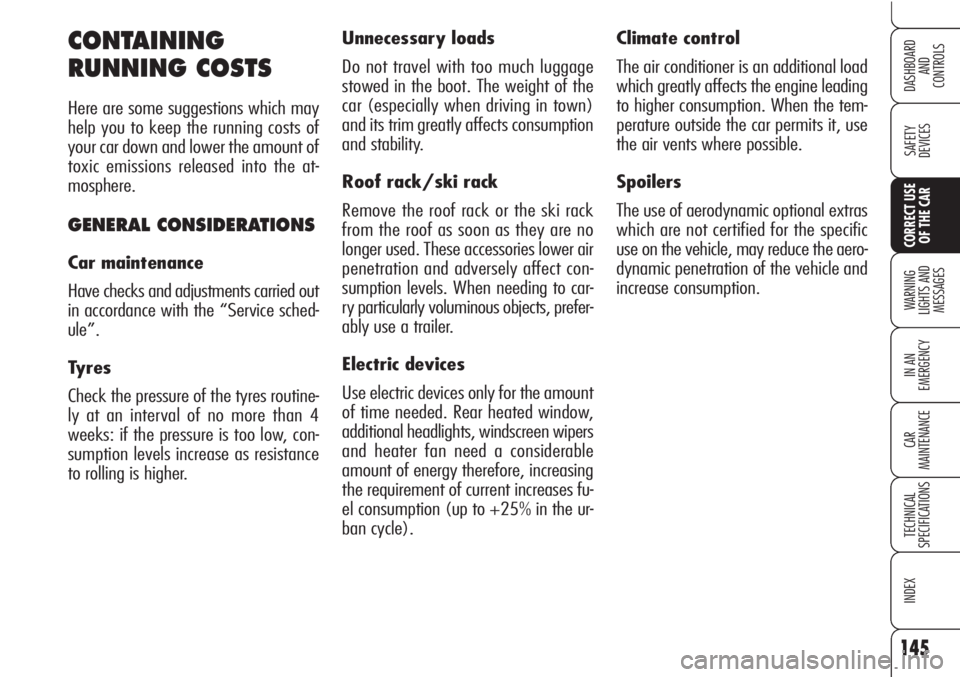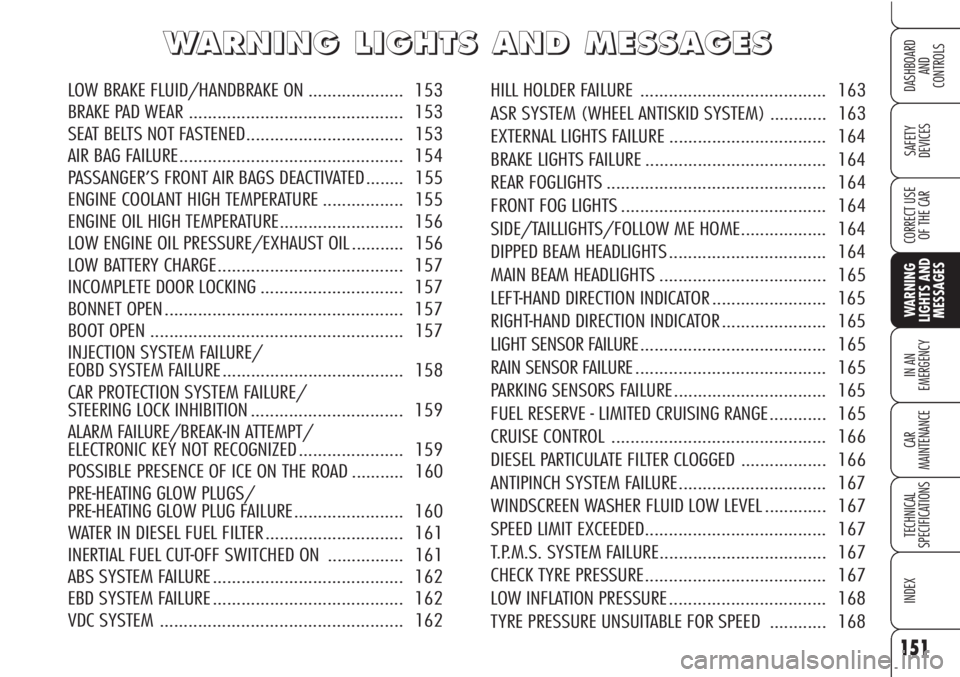2010 Alfa Romeo Brera/Spider low oil pressure
[x] Cancel search: low oil pressurePage 26 of 271

24
SAFETY
DEVICES
WARNING
LIGHTS AND
MESSAGES
IN AN
EMERGENCY
CAR
MAINTENANCE
TECHNICAL
SPECIFICATIONS
INDEX
DASHBOARD
AND
CONTROLS
CORRECT USE
OF THE CARENGINE OIL TEMPERATURE
GAUGE
(petrol versions except
1750 TURBO BENZINA)
fig. 17
This shows the temperature of the en-
gine oil and begins working when the
oil temperature exceeds approx. 70
°C.
If the pointer reaches the red sector, re-
duce your demand on the engine.
A0F0179mfig. 17
The turning on of the warning light `
when travelling (together with a mes-
sage on the display) indicates that the
oil temperature is too high; in this case,
stop the engine and contact Alfa Romeo
Authorized Services.
IMPORTANTThe temperature of the
engine oil may rise towards the maxi-
mum values (red sector) when the car
is driven at low speeds, uphill, fully
laden or during towing, especially if the
ambient temperature is high.
A0F0180mfig. 18
TURBOCHARGER PRESSURE
GAUGE (1750 TURBO
BENZINA and diesel
versions) fig. 18
This shows the turbocharger pressure
value.
Page 147 of 271

145
SAFETY
DEVICES
WARNING
LIGHTS AND
MESSAGES
IN AN
EMERGENCY
CAR
MAINTENANCE
TECHNICAL
SPECIFICATIONS
INDEX
DASHBOARD
AND
CONTROLS
CORRECT USE
OF THE CAR
Climate control
The air conditioner is an additional load
which greatly affects the engine leading
to higher consumption. When the tem-
perature outside the car permits it, use
the air vents where possible.
Spoilers
The use of aerodynamic optional extras
which are not certified for the specific
use on the vehicle, may reduce the aero-
dynamic penetration of the vehicle and
increase consumption. Unnecessary loads
Do not travel with too much luggage
stowed in the boot. The weight of the
car (especially when driving in town)
and its trim greatly affects consumption
and stability.
Roof rack/ski rack
Remove the roof rack or the ski rack
from the roof as soon as they are no
longer used. These accessories lower air
penetration and adversely affect con-
sumption levels. When needing to car-
ry particularly voluminous objects, prefer-
ably use a trailer.
Electric devices
Use electric devices only for the amount
of time needed. Rear heated window,
additional headlights, windscreen wipers
and heater fan need a considerable
amount of energy therefore, increasing
the requirement of current increases fu-
el consumption (up to +25% in the ur-
ban cycle).CONTAINING
RUNNING COSTS
Here are some suggestions which may
help you to keep the running costs of
your car down and lower the amount of
toxic emissions released into the at-
mosphere.
GENERAL CONSIDERATIONS
Car maintenance
Have checks and adjustments carried out
in accordance with the “Service sched-
ule”.
Tyres
Check the pressure of the tyres routine-
ly at an interval of no more than 4
weeks: if the pressure is too low, con-
sumption levels increase as resistance
to rolling is higher.
Page 153 of 271

151
SAFETY
DEVICES
WARNING
LIGHTS AND
MESSAGES
IN AN
EMERGENCY
CAR
MAINTENANCE
TECHNICAL
SPECIFICATIONS
INDEX
DASHBOARD
AND
CONTROLS
CORRECT USE
OF THE CAR
W W
A A
R R
N N
I I
N N
G G
L L
I I
G G
H H
T T
S S
A A
N N
D D
M M
E E
S S
S S
A A
G G
E E
S S
LOW BRAKE FLUID/HANDBRAKEON .................... 153
BRAKE PAD WEAR ............................................. 153
SEAT BELTS NOT FASTENED................................. 153
AIR BAG FAILURE............................................... 154
PASSANGER’S FRONT AIR BAGS DEACTIVATED ........ 155
ENGINE COOLANT HIGH TEMPERATURE ................. 155
ENGINE OIL HIGH TEMPERATURE.......................... 156
LOW ENGINE OIL PRESSURE/EXHAUST OIL ........... 156
LOW BATTERY CHARGE....................................... 157
INCOMPLETE DOOR LOCKING .............................. 157
BONNET OPEN.................................................. 157
BOOT OPEN..................................................... 157
INJECTION SYSTEM FAILURE/
EOBD SYSTEM FAILURE...................................... 158
CAR PROTECTION SYSTEM FAILURE/
STEERING LOCK INHIBITION ................................ 159
ALARM FAILURE/BREAK-IN ATTEMPT/
ELECTRONIC KEY NOT RECOGNIZED ...................... 159
POSSIBLE PRESENCE OF ICE ON THE ROAD ........... 160
PRE-HEATING GLOW PLUGS/
PRE-HEATING GLOW PLUG FAILURE....................... 160
WATER IN DIESEL FUEL FILTER ............................. 161
INERTIAL FUEL CUT-OFF SWITCHED ON ................ 161
ABS SYSTEM FAILURE ........................................ 162
EBD SYSTEM FAILURE ........................................ 162
VDC SYSTEM ................................................... 162HILL HOLDER FAILURE ....................................... 163
ASR SYSTEM (WHEEL ANTISKID SYSTEM) ............ 163
EXTERNAL LIGHTS FAILURE ................................. 164
BRAKE LIGHTS FAILURE ...................................... 164
REAR FOGLIGHTS.............................................. 164
FRONT FOG LIGHTS........................................... 164
SIDE/TAILLIGHTS/FOLLOW ME HOME.................. 164
DIPPED BEAM HEADLIGHTS ................................. 164
MAIN BEAM HEADLIGHTS ................................... 165
LEFT-HAND DIRECTION INDICATOR ........................ 165
RIGHT-HAND DIRECTION INDICATOR ...................... 165
LIGHT SENSOR FAILURE....................................... 165
RAIN SENSOR FAILURE........................................ 165
PARKING SENSORS FAILURE................................ 165
FUEL RESERVE - LIMITED CRUISING RANGE............ 165
CRUISE CONTROL............................................. 166
DIESEL PARTICULATE FILTER CLOGGED .................. 166
ANTIPINCH SYSTEM FAILURE............................... 167
WINDSCREEN WASHER FLUID LOW LEVEL ............. 167
SPEED LIMIT EXCEEDED...................................... 167
T.P.M.S. SYSTEM FAILURE................................... 167
CHECK TYRE PRESSURE...................................... 167
LOW INFLATION PRESSURE................................. 168
TYRE PRESSURE UNSUITABLE FOR SPEED ............ 168
Page 158 of 271

156
SAFETY
DEVICES
WARNING
LIGHTS AND
MESSAGES
IN AN
EMERGENCY
CAR
MAINTENANCE
TECHNICAL
SPECIFICATIONS
INDEX
DASHBOARD
AND
CONTROLS
CORRECT USE
OF THE CAR
ENGINE OIL
HIGH TEMPERATURE
Fitting the key into the ignition
device, the warning light (set on engine
oil temperature gauge) turns on but it
should go off a few seconds later.
Warning light turning on when travelling
(together with the message on the dis-
play) indicates that engine oil is too hot;
switch the engine off and contact Alfa
Romeo Authorized Services.
`
LIGHT STAYS ON:
LOW ENGINE OIL
PRESSURE (red)
FLASHING LIGHT:
EXHAUSTED ENGINE
OIL (only Diesel
versions with DPF –
red)
Fitting the key into the ignition device,
the warning light switches on and should
go out as soon as the engine is started.
1. Low engine oil pressure
The warning light turns on and stays on
constantly (for versions/markets, where
provided) along with the message on
the display when the system detects
that engine oil pressure is low.
v
If warning light `starts
flashing when travelling,
contact Alfa Romeo
Authorized Services.
2.Exhausted engine oil
(only Diesel versions with DPF)
The warning light will flash and a specific
message will appear on the display (for
versions/markets, where provided). The
warning light may flash in the follow-
ing ways, depending on the version:
– for 1 minute every two hours;
– for 3 minute cycles with the warning
light off for intervals of 5 seconds until
oil is changed.
After the initial warning, each time the
engine is started up, the warning light
will continue to flash in the above men-
tioned modes, until the oil is changed.
A specific message will appear on the dis-
play (for versions/markets, where pro-
vided) in addition to the warning light.
If the warning light flashes, this does not
mean that the car is defective but sim-
ply informs the driver that it is now nec-
essary to change the oil as a result of
regular vehicle use.
If the warning light
vturns on when
the vehicle is travelling (on
certain versions together with
the message on the display)
stop the engine immediately
and contact a Alfa Romeo
Authorized Services.
WARNING
Page 215 of 271

213
SAFETY
DEVICES
WARNING
LIGHTS AND
MESSAGES
IN AN
EMERGENCY
CAR
MAINTENANCE
TECHNICAL
SPECIFICATIONS
INDEX
DASHBOARD
AND
CONTROLS
CORRECT USE
OF THE CAR
USE OF THE CAR
UNDER HEAVY
CONDITIONS
Should prevailing use of the car be un-
der one of the following specially heavy
conditions:
❒trailer or caravan towing;
❒dusty roads;
❒short distances (less than 7-8 km)
and repeated with external temper-
atures below zero;
❒frequently idling engines or long dis-
tance low speed driving (e.g.: door-
to-door deliveries) or in case of a long
term inactivity;
❒urban routes;
carry out checks more frequently than
required on Service Schedule:
❒check front disk brake pad conditions
and wear;
❒check cleanness of bonnet and boot
locks and lever cleanness and lubri-
cation;
❒sight inspect the conditions of: en-
gine, gearbox, transmission, pipes
and hoses (exhaust - fuel - brakes),
rubber parts (boots, sleeves, bushes,
etc.);
❒check battery charge and fluid level
(electrolyte);
❒visual check on various drive belt con-
ditions;
❒change engine oil and oil filter, if re-
quired;
❒check and replace pollen filter, if re-
quired;
❒check and replace air cleaner, if re-
quired.
PERIODICAL CHECKS
Every 1,000 km or before long jour-
neys, check and top up if required:
❒engine coolant fluid level;
❒brake fluid level;
❒windscreen washer fluid level;
❒tyre pressure and conditions.
❒check light system operation (head-
lights, direction indicators, hazard
lights, etc.);
❒check windscreen wiper/washer op-
eration and windscreen/rear window
blade position/wear;
Every 3,000 km check and top up if re-
quired: engine oil level.
You are recommended to use
PETRONAS LUBRICANTSprod-
ucts, designed and produced specifical-
ly for Alfa Romeo cars (see table “Ca-
pacities” in section “Technical specifi-
cations”).